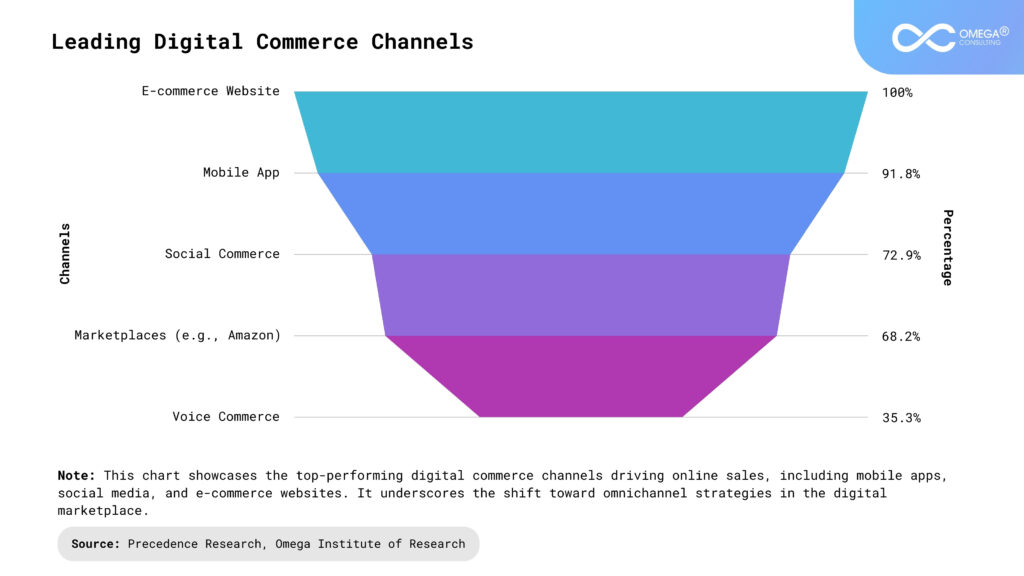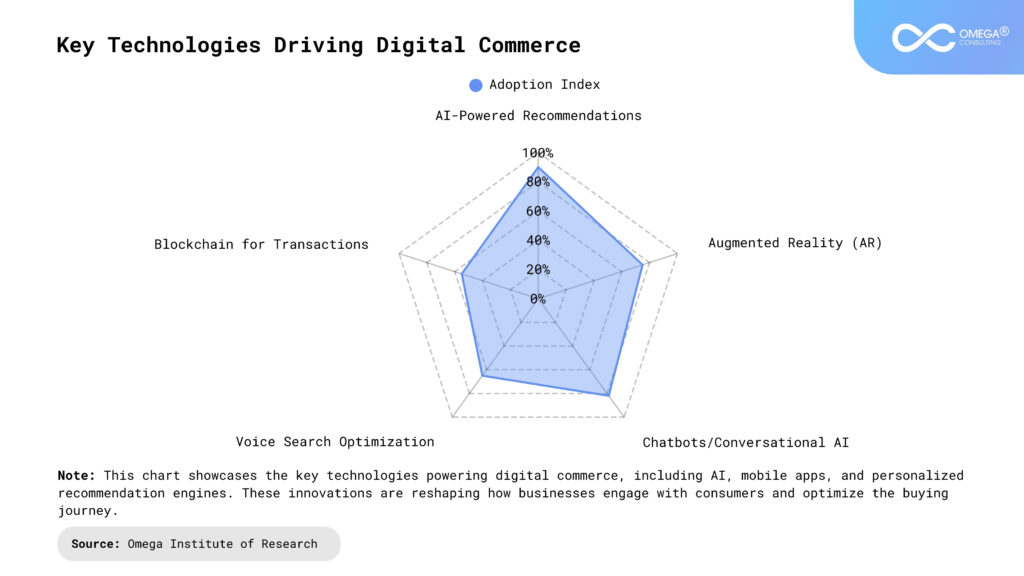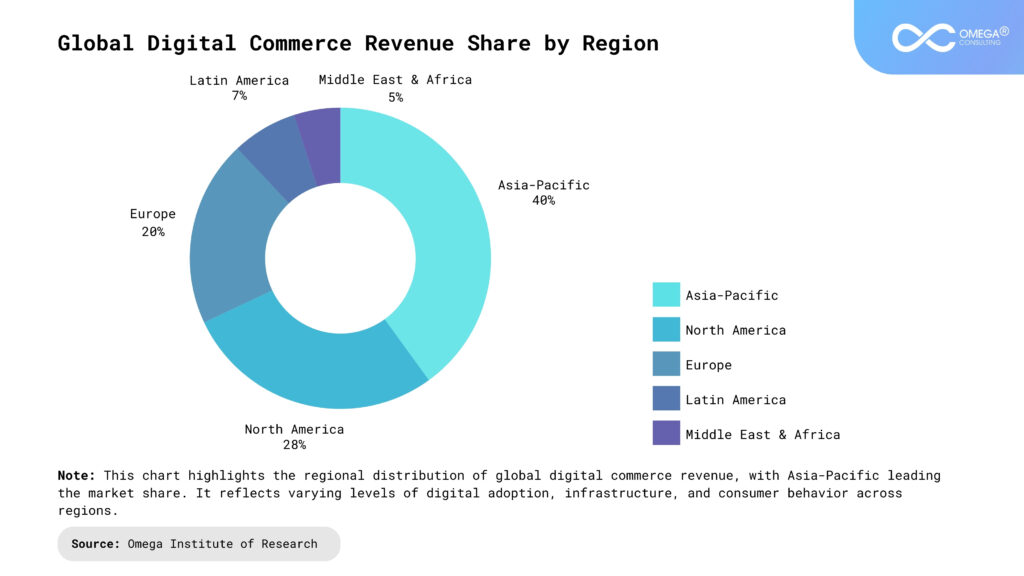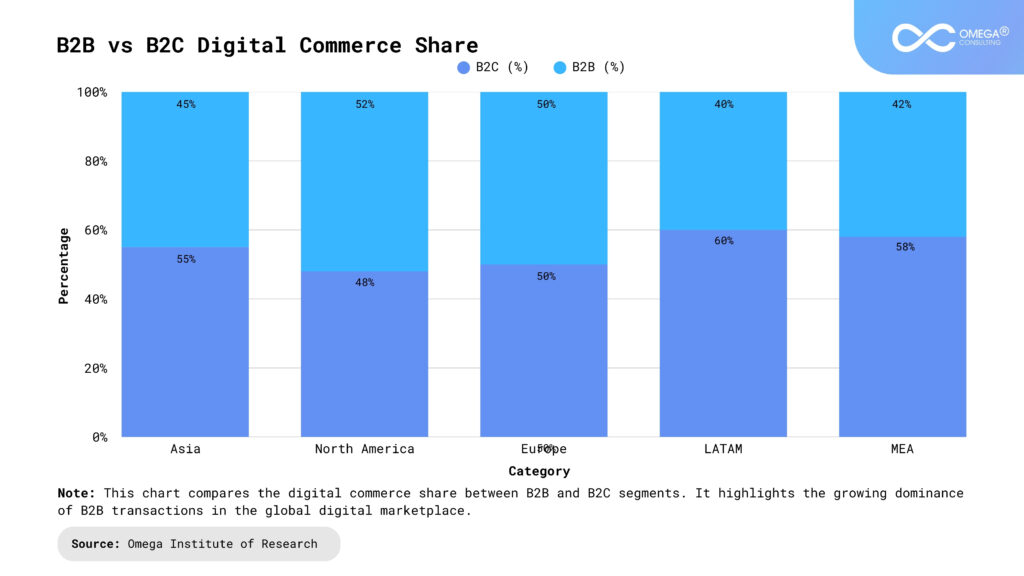- Industries
Industries
- Functions
Functions
- Insights
Insights
- Careers
Careers
- About Us
- Technology
- By Omega Team

Digital commerce is the modern evolution of traditional e-commerce, encompassing the buying and selling of goods and services through digital platforms such as websites, mobile apps, social media, and connected devices. It goes beyond simple online transactions to create a seamless, end-to-end customer experience. From product discovery to purchase, delivery, and post-sale interactions, digital commerce integrates technology to streamline each stage of the buyer’s journey. By leveraging tools such as artificial intelligence and machine learning, digital commerce enables personalized shopping experiences and more accurate predictions of consumer preferences. Whether a customer is browsing through a website, engaging with a product ad on social media, or receiving tailored recommendations via a mobile app, digital commerce makes it possible to meet them at every touchpoint. This approach not only enhances customer convenience and satisfaction but also supports business growth and operational efficiency on a global scale. As digital technologies continue to advance, digital commerce is reshaping the landscape of retail and services transforming both the way people shop and the way organizations interact with their audiences.
What is Digital Commerce?
Digital commerce refers to the buying and selling of goods and services through digital channels. It encompasses the entire customer journey—from product discovery to purchase, delivery, and post-sale support—across platforms such as websites, mobile applications, and social media. Supporting a range of transaction models, including B2C (business-to-consumer), B2B (business-to-business), and C2C (consumer-to-consumer), digital commerce is a modern business model that enhances convenience for consumers and streamlines operations for businesses.
Beyond transactions, digital commerce is reshaping supply chains with automation and real-time tracking. It empowers businesses of all sizes to reach broader markets through accessible digital platforms. Emerging technologies like augmented reality (AR) enable interactive shopping experiences, while social features turn mobile apps into dynamic storefronts. In the B2B arena, digital solutions are improving procurement processes through automation and data integration. With innovations in 5G, blockchain, and AI, digital commerce is evolving into a connected ecosystem that supports intelligent, data-driven business interactions.

Why is Digital Commerce Important?
Digital commerce has become an essential part of modern business, transforming how organizations operate and engage with their customers. Here are several key reasons why it plays such a critical role:
Global Reach: Digital commerce allows businesses to sell products or services to customers around the world, without the limitations of physical location. This expanded reach enables companies to grow faster and access new markets that were previously out of reach.
Cost Efficiency: Operating a digital storefront can be significantly more cost-effective than maintaining a physical retail space. Businesses can reduce overhead costs like rent, utilities, and in-store staffing—allowing them to reinvest those resources into growth, innovation, or customer experience.
Customer Convenience: Online shopping offers customers the flexibility to browse, compare, and purchase products at any time and from anywhere. Whether using a smartphone, tablet, or computer, customers can enjoy a seamless and hassle-free shopping experience.
Personalized Experiences: Through the use of customer data and analytics, digital commerce platforms can deliver personalized recommendations and tailored content. This level of customization helps improve customer satisfaction and fosters brand loyalty by making the shopping experience more relevant and engaging.
Economic Empowerment: Digital commerce opens up new opportunities for entrepreneurs and small businesses by lowering the barriers to entry. It supports job creation, innovation, and economic development by enabling more people to start, scale, and sustain successful businesses in a digital-first environment.
Key Technologies Driving Digital Commerce
Digital commerce continues to evolve through the rapid advancement of technology and changing consumer behaviors. Several key innovations are shaping how businesses operate and how consumers shop across digital platforms.
Mobile Commerce: With billions of smartphone users worldwide, mobile devices have become the primary channel for online shopping. Businesses are increasingly adopting mobile-first strategies to enhance user experience. Progressive Web Apps (PWAs) offer app-like functionality directly from the browser, eliminating the need for downloads. Meanwhile, mobile-specific features such as one-tap checkout, biometric authentication, digital wallets, and AR-based try-before-you-buy tools are streamlining the path to purchase. The global expansion of 5G networks is enabling faster, more immersive mobile experiences, including real-time customization and live shopping events. Optimizing for mobile is no longer optional; it’s essential for success in today’s digital marketplace.
Internet Penetration: Expanding access to the internet especially in emerging markets is fueling digital commerce growth. Increased connectivity is unlocking new opportunities in regions that were previously underserved, allowing businesses to reach wider and more diverse audiences. However, areas with limited infrastructure still require lightweight, low-bandwidth platforms and user-friendly designs to ensure accessibility. Localized content and simplified interfaces are key strategies for engaging users with varying levels of digital literacy.
Cross-Border E-Commerce: The digital marketplace is no longer limited by geography. Cross-border e-commerce is growing rapidly, driven by global consumer interest in unique offerings and competitive pricing. To succeed internationally, businesses must navigate localized payment methods, currency conversion, customs requirements, and regional logistics. Overcoming these barriers opens the door to significant growth in international markets.
Payment Technologies: Payment innovation is central to the digital commerce experience. The shift from traditional methods to diverse digital solutions includes biometric authentication, tokenized transactions, decentralized payment models, installment-based payment plans, embedded finance options, and instant transfer systems. Digital wallets have emerged as a leading payment method, offering convenience and security across a wide range of devices and platforms. In parallel, open banking frameworks are enabling new forms of financial connectivity and customer-centric experiences.
Social Commerce: Social platforms are transforming from marketing tools into complete shopping environments. Features such as integrated product tagging, live selling, influencer-driven campaigns, and seamless in-app purchasing are turning content into commerce. These capabilities create intuitive shopping journeys where users can discover, evaluate, and purchase products without leaving their favorite social platforms. The fusion of entertainment and shopping is redefining how brands connect with consumers.
Subscription commerce: Subscription-based models are reshaping consumer relationships by offering convenience, personalization, and value. These models range from replenishment services and access-based memberships to curated experiences tailored to customer preferences. They also foster long-term loyalty and predictable revenue streams for businesses.
Sustainable Commerce: Sustainability is increasingly influencing purchase decisions. Businesses are responding by offering carbon-neutral delivery, recyclable packaging, transparent product sourcing, and digital product passports. Circular commerce initiatives, which focus on reuse, resale, and recycling, are gaining traction as consumers prioritize environmental responsibility.

Global E-Commerce Market Size and Growth Projections
Asia: As of 2023, Asia led the global digital commerce landscape with an estimated market value of $3.49 billion, solidifying its status as the world’s largest e-commerce region. Growth is being propelled by widespread smartphone usage, expanding mobile internet access, and increasing adoption of digital payments. Social commerce and mobile-first platforms are also playing a significant role in shaping consumer behavior. The region is expected to maintain this momentum, with the market forecasted to approach $4 billion by 2025.
North America: North America reached $1.1 billion in e-commerce sales in 2023 and is projected to grow to $1.2 billion by 2025. The region benefits from robust digital infrastructure, mature fulfillment networks, and a strong culture of online consumer engagement. Continued investments in omnichannel capabilities and personalized shopping experiences are expected to drive steady growth in the coming years.
Europe: Europe’s e-commerce market was valued at $604 billion in 2023, with forecasts indicating growth to $659 billion by 2025. The region is notable for its seamless cross-border trade, environmentally conscious logistics practices, and widespread adoption of diverse payment methods. While Western Europe remains the primary driver of market value, Eastern European nations are emerging as fast-growth areas due to digital transformation and increasing internet penetration.
Latin America: In 2023, Latin America’s digital commerce sector generated approximately $168 billion, with growth projected to reach $205 billion by 2025. Regional development is being accelerated by mobile commerce adoption, increased internet availability, and a rising middle class. Efforts to improve logistics and digital payment systems are further supporting the market’s expansion.
Africa: Africa’s e-commerce market stood at $117 billion in 2023 and is expected to grow to $131 billion by 2025. The continent’s growth trajectory is shaped by strong mobile phone usage, the dominance of mobile money in digital transactions, and a youthful, digitally engaged population. Infrastructure improvements and fintech innovation are key enablers of future growth.
Market Outlook: Global e-commerce continues to evolve with unique dynamics across regions. Asia remains the dominant force, while North America and Europe offer stable, innovation-led growth. Latin America and Africa are emerging as promising frontiers with untapped potential. Common challenges across regions include enhancing supply chain efficiency, ensuring payment security, optimizing last-mile delivery, and simplifying cross-border commerce. Looking ahead, the global e-commerce market is set to maintain strong momentum through 2025, driven by technology advancements and evolving consumer expectations.

Emerging Technologies in Digital Commerce
Modern commerce platforms now deploy sophisticated AI systems that fundamentally transform customer experiences and operational efficiency. Hyper-personalization engines analyze thousands of data points in real time from browsing history to social media activity — to deliver individually tailored product recommendations. These systems achieve 20–35% higher conversion rates compared to traditional methods.
Predictive analytics revolutionizes inventory management by forecasting demand with 90%+ accuracy, reducing overstock situations by up to 30% (Forrester, 2023). Retail giants like Amazon leverage these systems to optimize warehouse placements and anticipate regional demand spikes.
AI-powered visual search technology enables shoppers to upload images and find matching products instantly. Pinterest reports that visual search drives 85% higher engagement than text queries, with major retailers seeing 25% conversion rates from these interactions.
Dynamic pricing algorithms automatically adjust prices based on market conditions, competitor pricing, and demand fluctuations. Ride-sharing platforms demonstrate this technology’s power, with Uber’s algorithm processing millions of data points to set optimal fares in real time.
Blockchain Innovation
Smart contracts automate complex transactions without intermediaries, executing payments automatically when delivery confirmation occurs. De Beers employs this for diamond authentication, reducing fraud by 99% in pilot programs.Decentralized marketplaces like OpenBazaar eliminate platform fees by connecting buyers and sellers directly through blockchain protocols. Early adopters report 40–60% lower transaction costs compared to traditional e-commerce platforms.
Product authenticity verification through blockchain creates immutable product histories. Luxury brands like LVMH implement this to combat counterfeiting, with each item receiving a digital certificate tracing its entire supply chain journey.
Cryptocurrency payment gateways now process billions in transactions annually, with Shopify merchants reporting 18% higher average order values from crypto-paying customers. New solutions enable instant conversion to fiat currency, eliminating volatility concerns for merchants. These technologies collectively drive the next evolution of digital commerce, with AI/ML enhancing customer experiences and operational efficiency while blockchain solutions address trust and transparency challenges. Early adopters gain significant competitive advantages — Nike’s AI-driven demand forecasting reduced excess inventory by $300 million annually, while Walmart’s blockchain food tracking system reduced contamination investigation times from 7 days to 2.2 seconds. The convergence of these technologies will continue reshaping commerce landscapes across all industries.

Challenges in Digital Commerce Implementation
Data Privacy & Security Risks: The increasing volume of sensitive customer data makes e-commerce platforms prime targets for cyberattacks. High-profile breaches in 2023 exposed over 500 million user records, eroding consumer trust. Strict GDPR and CCPA compliance requirements create operational complexities, with non-compliance fines reaching €20 million or 4% of global revenue. Payment fraud remains rampant, accounting for 35% of all e-commerce losses. Businesses must invest in advanced encryption, tokenization, and continuous security monitoring while maintaining transparent data practices.
Supply Chain Disruptions: Global logistics networks remain vulnerable to geopolitical conflicts, natural disasters, and demand fluctuations. Over 60% of retailers experienced significant inventory shortages in 2023, while shipping costs remained 300% above pre-pandemic levels. Just-in-time inventory models struggle with component shortages, and 40% of cross-border orders face customs delays. Companies are forced to diversify suppliers, implement AI-driven demand forecasting, and develop contingency plans – all while consumers expect faster, cheaper deliveries.
Technology Integration Complexities: Legacy systems struggle to connect with modern AI tools, blockchain platforms, and omnichannel solutions. 73% of retailers report integration challenges when adopting new technologies leading to data silos and operational inefficiencies. The average enterprise uses 89 different SaaS tools, creating compatibility issues and steep learning curves. Implementation costs often exceed projections by 2–3x, while employee resistance slows adoption. Successful digital transformation requires phased rollouts, API-first architectures, and comprehensive change management programs.
The Future of Digital Commerce
Hyper-Personalization Through Advanced AI: By 2025, AI is set to deliver real-time, context-aware shopping experiences that adapt to individual emotions and preferences. Systems will leverage biometric indicators such as voice tone and facial expressions during virtual interactions to provide product recommendations with extremely high accuracy. Generative AI will further enhance the shopping journey by producing dynamic product descriptions, personalized videos, and even custom-designed items on demand. The rise of “anticipatory commerce” where AI predicts a consumer’s needs before they are consciously aware of them is expected to influence 30–50% of purchasing decisions.
Frictionless and Autonomous Transactions: Looking ahead to 2030, blockchain and IoT will power autonomous retail environments where the entire shopping process is seamless. Smart stores will incorporate computer vision, connected carts, and sensor technology to monitor customer behavior and selected products in real time. Payments will be processed automatically via biometric authentication as customers exit, eliminating traditional checkouts and significantly reducing transaction time. These systems promise to enhance convenience, speed, and operational efficiency.
Immersive Metaverse Commerce: By 2026, a significant portion of consumers are expected to engage in commerce within immersive 3D virtual environments. Using AR and VR technologies, shoppers will be able to interact with highly realistic digital twins of physical products. Non-fungible tokens (NFTs) will add a new layer of digital ownership and loyalty, enabling exclusive benefits and persistent identity across platforms. The fusion of spatial computing, social commerce, and Web3 technologies will result in highly engaging, interoperable digital marketplaces.
Preparing for the Next Era: These innovations will blur the lines between physical and digital commerce, creating a fluid, personalized, and immersive ecosystem. Businesses must begin preparing now by transitioning toward AI-centric operations, investing in decentralized technologies, and reimagining customer experiences for spatial and biometric interfaces. Those who adapt early to this paradigm shift will be best positioned to capture emerging revenue streams and shape the future of commerce.
Conclusion
Digital commerce has reshaped global business by unlocking new levels of growth, efficiency, and customer engagement through technologies like AI, blockchain, and omnichannel integration. While it offers immense potential, it also presents challenges such as cybersecurity threats, supply chain disruptions, and integration hurdles that demand proactive and strategic responses. The future will bring even greater transformation, with hyper-personalized experiences, autonomous transactions, and immersive digital environments redefining how consumers interact with brands. To stay competitive, businesses must embrace innovation, prioritize security and sustainability, and remain agile and customer-centric. As digital commerce continues to evolve, those who adapt will shape the next era of commerce and lead its global impact.
- https://www.statista.com/markets/419/topic/491/logistics/
- https://www.technologyreview.com/tag/digital-commerce/
- https://www.gartner.com/en/articles/5-digital-commerce-trends-for-2023
- https://www.accenture.com/us-en/insights/retail/hyper-relevance
Subscribe
Select topics and stay current with our latest insights
- Functions